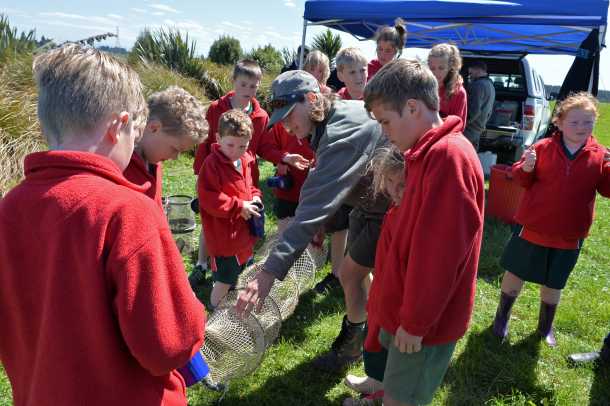 Fonterra and the Department of Conservation (DOC) held an open day recently to update the local community on their 10-year Living Water programme to improve water quality in the Te Waihora catchment in Canterbury.
Fonterra and the Department of Conservation (DOC) held an open day recently to update the local community on their 10-year Living Water programme to improve water quality in the Te Waihora catchment in Canterbury.
Held at Lincoln University Dairy Farm and finishing at Liffey Stream, where local school children launched flax woven fish into the stream, the open day provided an opportunity for the local community to hear about work being done in the Te Waihora catchment by Fonterra and DOC in partnership with local dairy farmers, Ngāi Tahu and a range of key stakeholders.
Work in the catchment has included supporting Canterbury University’s Freshwater Ecology Research Group on a drain rehabilitation trial on a Fonterra farm in the Te Waihora catchment. The trial is aimed at developing techniques to enhance the benefits of riparian fencing and planting. The Living Water partnership team has also carried out an ecological assessment at the lake margin and will be undertaking further scientific and ecological assessments through the coming year.
Fonterra Living Water Project Manager Nicola Toki said Te Waihora is one of New Zealand’s most important wetland ecosystems and as with other sensitive wetlands in the Living Water partnership, the focus in the first year has been on establishing a solid scientific and stakeholder platform on which to make measurable improvements to water quality in the catchment.
“Te Waihora has been recognised as an outstanding habitat for wildlife, indigenous wetland vegetation and fish, and we want to protect and enhance that in partnership with DOC, our farmers Ngāi Tahu and the wider community for future generations to enjoy,” said Toki.
“In our first year we’ve focused on understanding the catchment and implementing robust scientific monitoring systems to ensure future work will make positive, measurable changes. We’ve identified collaborative opportunities with a number of organisations which we’ll roll out over the coming year. We have also started work on restoration programmes.”
Mrs Toki said the Living Water team is concentrating on the Ararira/LII subcatchment within Te Waihora because it is home to both a rural and urban community as well as having significant ecological values. The Ararira/LII River begins near Lincoln township, travels through rural land dedicated to a range of uses, and finishes at Te Waihora on a Wildlife Reserve.
“What’s exciting about working in the Ararira/LII catchment is that it allows us to bring together the rural and urban community to address water quality and biodiversity issues. We will be trialling a range of different tools to address water quality and expect that the outcomes will be applicable elsewhere,” she said.
DOC Commercial Partnerships Director Geoff Ensor said the open days are a great chance for the local community to understand the importance of wetlands and the work being undertaken in their backyard to improve water quality.
“These open days give people a sense of the importance of wetlands to local biodiversity and that improving water quality is a real team effort. From council to iwi, farmers and many others, we are all bound by a common interest to protect and enhance New Zealand’s wetlands and good work is underway,” said Ensor.
The day included a freshwater fish display, an introduction to local invertebrates, detail on plantings on farm and the role of riparian vegetation and a water quality activity. Local schoolchildren from Lincoln Primary School concluded the event at the head of the Liffey Stream launching hand-woven flax fish into the water to symbolise the community’s commitment to improving the health of the river.
About the Fonterra DOC Living Water programme
The Living Water programme is undertaking similar work with partner organisations and local communities to improve water quality at four other catchment sites in significant dairying regions throughout New Zealand.
The other Living Water catchments are Hikurangi – feeding into the northern end of the Kaipara Harbour, Pūkorokoro / Miranda at Tīkapa Moana / Firth of Thames, three Waikato Peat Lakes – Areare, Ruatuna and Rotomānuka and Awarua-Waituna in Southland.



